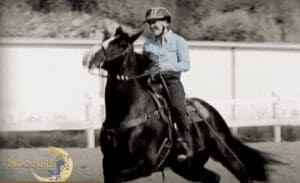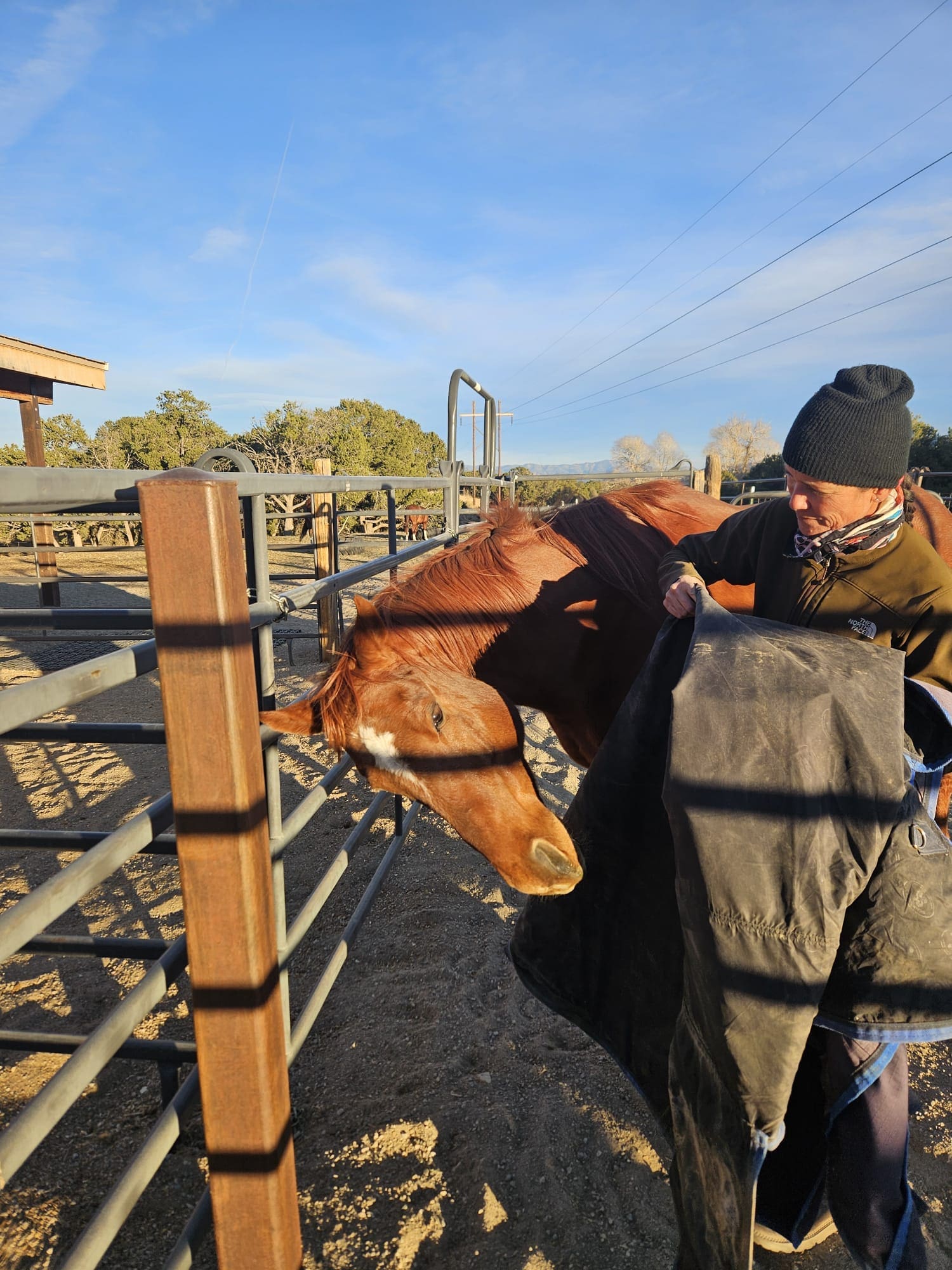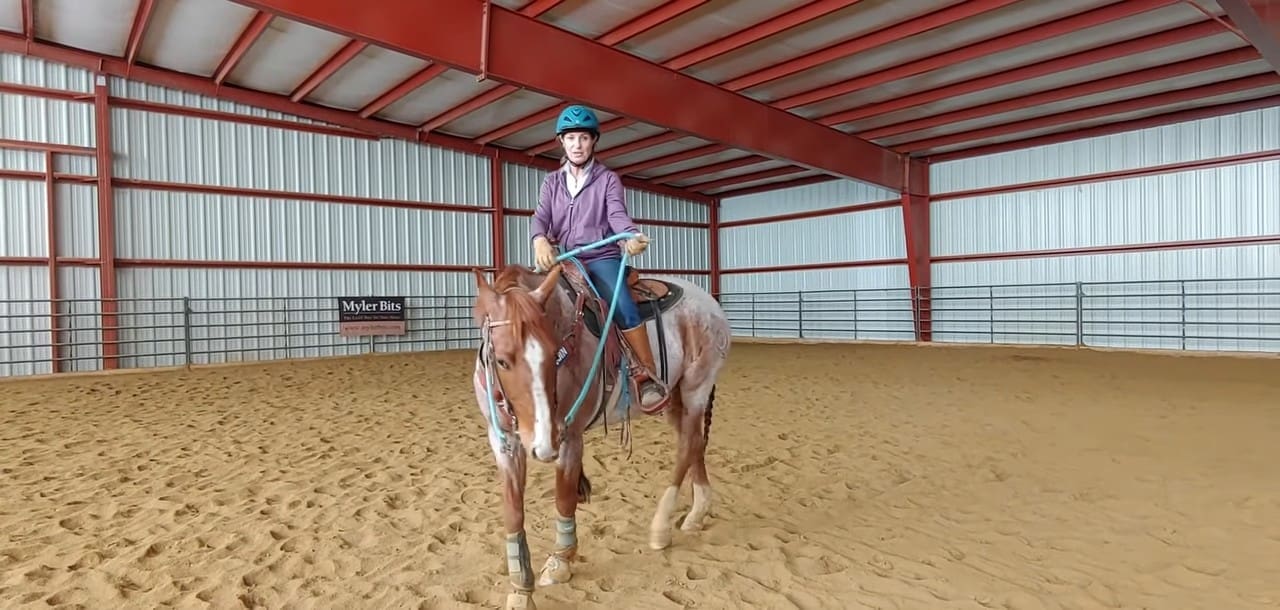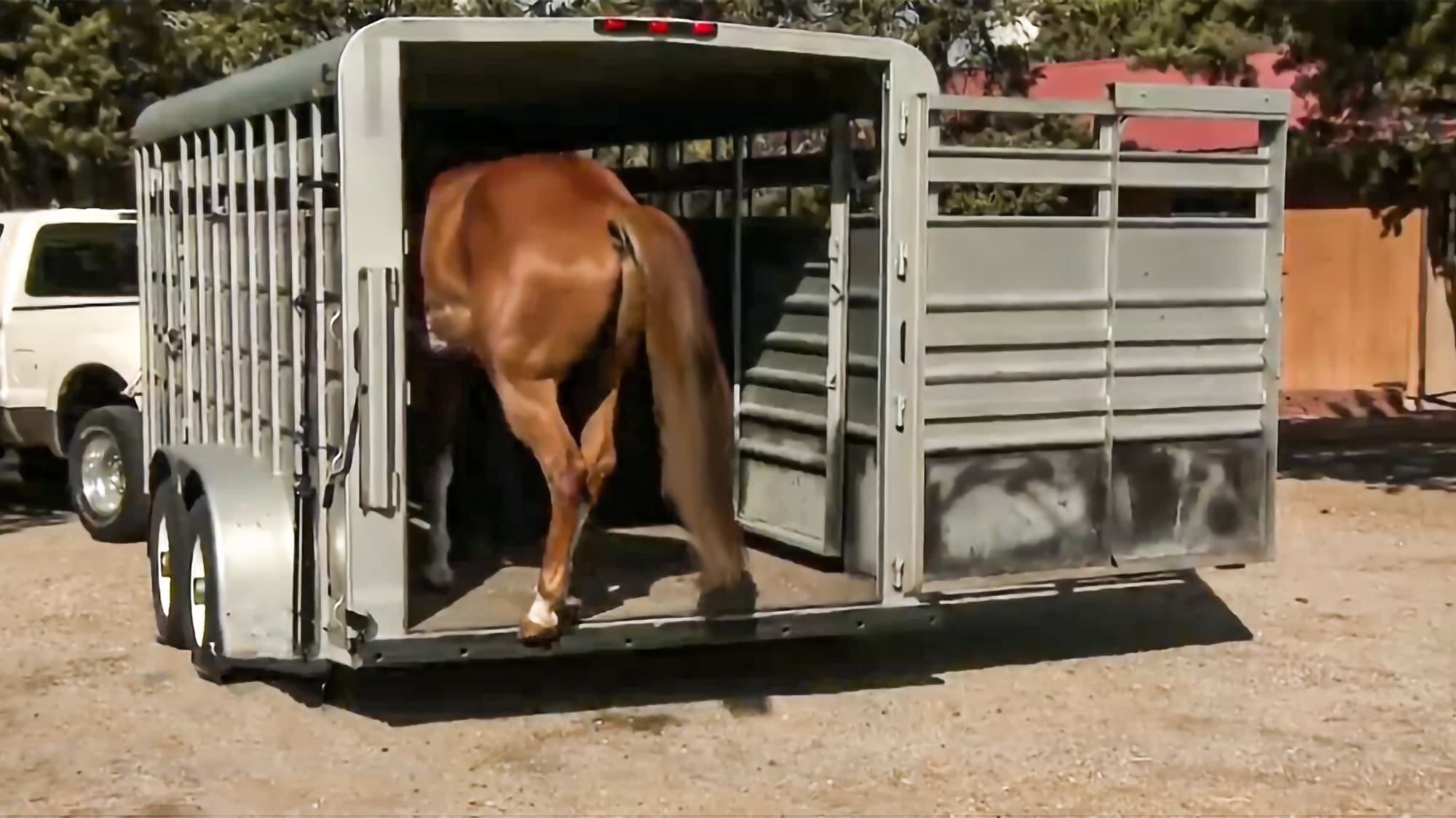
Your horse didn’t exactly volunteer to join you on your next road trip, and isn’t pining for a big adventure or “revenge travel” to make up for lost time over the last couple years of pandemic restrictions. It’s important that our horses are well prepared to travel, and that we do our best to keep them healthy and content.
Making sure everything runs smoothly starts well before you pull out of the barnyard with a loaded trailer. To be fully prepared, you’ll probably have to start weeks or even months ahead of time—including trailer training for your horse, addressing health concerns, reducing stressors as much as possible, and strategic travel planning.
Loading and Unloading
There’s nothing normal or natural about a horse voluntarily loading into a metal tube of confinement. In fact, most horses view a trailer as a mobile bear den until proven otherwise. If your horse is completely inexperienced, trailer loading training should start months before your trip in order to address loading, unloading, and riding quietly in the trailer once you are underway.
Without question, you are more likely to have resistance to loading when you are in a hurry to get somewhere. Plan trailer training sessions ahead of time when you have no agenda to leave. This creates a low-stress environment and helps the horse build confidence.
The techniques I use with an inexperienced horse or a horse that has existing trailer loading problems teach the horse that the trailer is a safe place, and to approach it eagerly. It initially involves two people, but the training happens fast, and pretty soon, the horse will be loading automatically.
Once the horse is loading and unloading without hesitation or stress, it’s time to make a big investment in your horse’s travel future. Few things will have as long-lasting an effect as feeding your horse in the hitched-up trailer—twice a day for a week. By the second day of eating its entire meal in the trailer, the horse will start to think about the trailer as its happy place, and feel relaxed and comfortable.
After that, it’s time to go on a short drive—maybe just around the block. Getting the horse used to the full confinement of a closed-up, moving trailer may involve several small ventures.
If you will be traveling with your horse alone, you’ll need to develop loading and unloading procedures to make sure you and your horses stay safe. Remember, always close the horse in the trailer before tying the horse and never open the trailer door or divider until the horse is untied.
If a tied horse panics and tries to escape the trailer, it could be horribly injured. I always use a slow-release clip on the lead rope for this reason. It’s quick and easy to clip and unclip the horse in the trailer, and if the horse should pull back while clipped, the device gives a slow release to prevent casualties.
Inevitably, your well-trained, reliable loader may one day decide not to get in the trailer. Traveling with horses is much easier when you have help, but many of us take trips alone. If you will be loading and unloading horses by yourself, you’ll want to be prepared for any loading issues that crop up. You don’t necessarily see this coming, so I always carry a rope halter with a 20’ lead and a training flag in the trailer so I am prepared whether or not I’m by myself.
Important Safety Note: The rope halter and 20′ lead are tools to use only while you are training the horse to load or giving it a refresher when it refuses to load. After the horse is again loading reliably, switch a flat breakaway halter for hauling. Put the slow-release clip on your regular lead when hauling (not while you are training) for added safety.
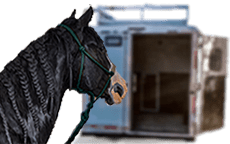
Rarin' to go on your next trip? Sometimes horses have other ideas...
Off-days happen, be prepared anywhere you go!
Life Skills for Horses Away from Home
Leaving their home territory and venturing not the unknown is very scary for horses, especially if they are leaving their herd behind. The more life experience a horse has—like going to new places, sleeping in a strange stall, tolerating unknown horses, and performing under pressure—the better they become at traveling.
If your horse has no travel experience, this will take a lot of work and time to accomplish.
I’ll never forget a lovely, well-trained horse that came to one of my clinics with its owner. They were a high-functioning pair, and a pleasure to have in my arena, but when it came time to put the horse in a box stall at the end of the day, the horse had a complete meltdown and turned out to be claustrophobic.
The owner had to make the long drive home that night and miss the next day, and what started as an incredible weekend, ended in frustration and exhaustion. The owner told me that she didn’t believe in keeping horses in stalls.
While I appreciate the overall sentiment, this isn’t always possible 100% of the time. For most horses, there will come a time when they need to be stalled—for health reasons, after evacuation from a natural disaster, because the owner wants to attend a multi-day event, or any number of other reasons.
Just like getting used to getting on a trailer, being shut in a trailer, and learning to ride comfortably in the trailer, your horse also needs to get accustomed to whatever accommodations are available away from home. Whether it’s tied to a trailer or highline at a campsite, in a small pen or temporary electric fence enclosure, or in a box stall—the horse needs to gain experience over time.
Your horse also needs training and experience performing in different locations. I have a ton of information in my Academy about how horses can be location-specific in what they learn and the process of training and seasoning. Horses are lightning quick learners, but the progression from when a horse initially learns a new skill, then becomes fluent in that skill, then becomes “generalized” in that skill (meaning they can perform the skill anytime, anywhere and under intense pressure) literally takes years.
It’s important to have a plan and give yourself—and your horse— time to accomplish all of this. Cramming and jamming doesn’t work if you want your horse to be confident and relaxed away from home.
Health Concerns for Traveling Horses
The horses we take on road trips are fully vaccinated in the spring, and often receive a booster in the fall (especially the younger horses who may not have had much exposure to germs). Hygiene when traveling is very important. When you get a group of horses together in one facility that come from all over the place, it’s easy for contagions to spread.
I am always prepared with my own buckets and feed pans, and avoid shared water tanks. I know horses don’t like solid walled stalls, but when horses touch and nuzzle, the potential to spread germs increases exponentially. I carry a jug of disinfectant in the trailer in case I need to spray some surfaces in my horse’s “hotel room”.
All horses are prone to gastric ulcers—some more than others. If my horse is more susceptible to ulcers, they get ulcer medication regularly, and the dosage is increased when we travel. If not, I’ll start giving them ulcer medication starting a couple of days before travel. At its best, traveling with horses is incredibly stressful for the horse, so attention to prevention is important.
Dehydration is another major concern, especially in the summer. Many horses generally don’t drink or eat well in the trailer. Add to that high temperatures, sweating and stress, and dehydration can happen fast. Horses can also be finicky about the taste or smell of their water if it’s different from what they are used to, so carrying water from home as your drive is a good idea. A familiar bucket and/or a touch of sweet flavoring in the water often helps, (but they have to get used to that at home first).
Knowing that colic is the #1 killer of horses—and stress and dehydration are contributing factors—keeping a well-stocked first aid kit on board my rig is essential. Just the basics will typically do—colic and wound-care supplies, a thermometer, and a stethoscope.

Solid Loop Rope Reins | Julie's Favorite & Voted #1 by Fans!
Soft & Clear Communication • Easy to Hold & Manage • Different Colors & Lengths to Fit Your Horse!
Travel Logistics
Beyond acquiring the horse’s required documentation, you’ll have to plan a route and time frame that addresses the comfort and safety of your horse so it can perform to your satisfaction on the other end.
State law and the recommendations of your vet, as well as the event or facility you are traveling to, and whether or not you are crossing state lines, will determine what specific travel documents you’ll need. Generally, you’ll need a negative Coggins Test dated within 12 months, a government issued health certificate (it’s not proof of health, it makes our horse traceable in case of a serious infectious outbreak), and proof of ownership. Western states require “brand” papers or proof of ownership.
Planning a route involves many variables—like how far you are traveling, what your horse will be expected to do when you get there, how long you will be gone, and the expected traffic and weather.
In the summer months, road heat and other environmental factors can make travel dangerous for your horse. In the winter, road conditions can easily stop a trip—especially living in colder areas, like where I live high in the Rocky Mountains. Passing through a big city in the heart of rush hour would be hard on your horse and stressful for the driver, so planning a route and schedule around that is important.
If my horse travels well and can rest for a day at our destination before it has to perform, I like to power through the trip and stop only when necessary. However, if the drive is more than ten hours, I’d think about an overnight spot. This entails more research and planning to find safe stops that can accommodate the horses overnight, like horse hotels or fairgrounds.
Unloading horses during the trip for R&R comes with certain risks, so I usually try to avoid it. If you do unload, make sure it’s in a safe area—no asphalt, concrete or traffic—and there is comfort for the horse (shade, water, grass, room to walk). Given that occasionally well-trained horses can decide not to get back in the trailer after being in there for a long period of time, when you unload for a pit stop, be prepared to deal with your horse resisting or refusing to load.
If you will be gone overnight, you will also have to make plans to either pack or find appropriate feed and supplies for your horse while traveling. We all know it’s smart to change a horse feed gradually, and it’s especially important not to go from a low-protein hay source to a turbocharged source.
If my horse was eating an alfalfa-grass mix at home, I wouldn’t worry about switching to a low-protein grass hay. However, going the other way around could be disastrous for your horse and your road trip.
Hay is the biggest challenge, and if you don’t have room to bring it with you from home, you’ll want to know what kind of hay is commonly available in the area you are traveling to. Be aware that hay is vastly different in different parts of the country. You may want to consider altering your horse’s diet ahead of your trip and/or using pre-packaged, processed hay on the road.
Comfortable Accommodations
One of the most important considerations for your horse’s comfort while traveling is the design of your horse trailer. First, is it big enough for your horse?
- If a horse can’t lift his head for balance, he’s going to be difficult to load, and uncomfortable in the trailer.
- If a horse is too long for a slant load, and his face is jammed up against the window, imagine the misery of having to stay like that for any period of time.
- If a horse is too tall for a standard-sized horse trailer, it’s going to eventually hit its head and get hurt.
Any of these things can result in a horse with a legitimate reason to never want to get on a trailer again.
Second, what type of trailer fits your horse’s needs best? I have Quarter Horses (and short-coupled ones at that), so riding in a slant load is most comfortable for them—especially driving in the mountains. From watching my in-trailer camera, I can see how they lean on the sides on turns and sit back on their butts for balance. I can’t go anywhere with my horses without driving over at least one mountain pass, if not more, so the slant load works best for me.
Another important consideration for your horse’s comfort in the trailer is the ventilation. Unless the trailer is open on the sides, I want a roof vent for every horse (wide open), and windows that open in front and behind every horse.
I am very careful about how much dust and fumes are circulating inside the trailer (you can tell by how much dust is on your horse’s back when you unload). Respiratory issues can easily develop inside a hot dusty trailer, especially when the horse’s head is tied up.
There’s more to traveling with horses than planning a trip to Disney World! Fortunately, part of the fun is in the planning and prepping. The more prepared you are, the smoother the trip will go for you and your horse. Remember, when it comes to horses, it’s about the journey—not the destination. Enjoy the ride!

